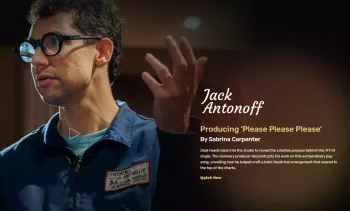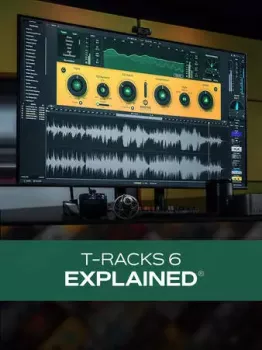P2P | 02 January 2024 | 3.73 GB
英文简介:
"Burn" is the eighth studio album by the legendary British rock band Deep Purple, released in February 1974. This album marked a significant change in the band's lineup, as it was the first to feature then-new members David Coverdale (vocals) and Glenn Hughes (bass, vocals), who replaced Ian Gillan and Roger Glover, respectively. However, the guitar wizardry of Ritchie Blackmore remained intact, and this album showcases his incredible talent and innovative techniques. Burn hit number three on the UK Albums Chart and number nine on the US Billboard 200, making it one of the band’s highest-rated and critically acclaimed releases.
In this guitar lesson course, LickLibrary veteran Danny Gill walks you through the many highlights of each song from this essential album one phrase at a time, including Ritchie Blackmore’s legendary guitar riffs and lead lines from tracks such as; “Sail Away,” “Burn,” and the epic “Mistreated.”
Ritchie Blackmore: The Lead Guitarist
Ritchie Blackmore, a founding member of Deep Purple, is considered one of the most influential guitarists of all time. His contributions to the "Burn" album were immense, providing both driving riffs and mesmerizing solos. Blackmore's style is a blend of blues, rock, and classical influences, with a heavy focus on melodic lines and virtuosic techniques.
Blackmore's playing is characterized by a combination of aggressive picking and smooth legato phrasing, giving his solos a unique sense of fluidity and precision. He is known for using a variety of scales and modes, ranging from the traditional pentatonic and blues scales to more exotic choices such as harmonic minor and diminished scales. His use of these diverse scales allows him to create tension and resolution within his solos, resulting in a dynamic and expressive sound.
In addition to his technical prowess, Blackmore is also renowned for his innovative use of guitar effects. He was one of the early adopters of the wah-wah pedal, which he often used to add extra texture and expressiveness to his solos. Additionally, Blackmore frequently employed tape echo and phasing effects, which helped to create a sense of space and depth in his playing.
Track-by-Track Analysis
1. Burn
The album's opening track and title song, "Burn," is a high-energy rocker that showcases Blackmore's prowess. The main riff is based on the G minor pentatonic scale, featuring palm-muted power chords and a galloping rhythm [^1^]. Blackmore employs a variety of techniques throughout the song, including string bending, vibrato, and alternate picking.
Blackmore's solo in "Burn" is a masterclass in rock guitar playing. He begins with a rapid ascending run, utilizing the G minor pentatonic scale and making use of the hammer-on and pull-off techniques. The solo continues with a series of tasteful bends and vibrato, showcasing Blackmore's excellent control and expressiveness. Towards the end of the solo, he employs a series of tremolo-picked runs, adding intensity to the climax of the solo.
2. Might Just Take Your Life
This bluesy track starts with a Hammond organ intro, followed by a powerful riff in A minor, which serves as the backbone of the song. Blackmore's solo features a mix of pentatonic and blues scale licks, with an emphasis on bends and slides.
During the solo, Blackmore demonstrates his ability to create tension by incorporating chromatic passing tones and double-stops. He also uses pre-bends and pinched harmonics to add a unique and expressive character to the solo.
3. Lay Down, Stay Down
"Lay Down, Stay Down" is an up-tempo rock song in E minor, featuring a driving riff and a catchy chorus. The main riff showcases Blackmore's ability to create syncopated rhythms, using palm muting to accentuate certain beats. The pre-chorus section introduces a dual-guitar harmony, which adds a melodic layer to the song.
The guitar solo in this track is a blend of E minor pentatonic and E Dorian licks. Blackmore employs a variety of techniques, such as legato, alternate picking, and string bending. He also uses unison bends to create a powerful, vocal-like quality to his solo.
4. Sail Away
"Sail Away" is a mid-tempo track with a prominent bass line and a moody atmosphere. The main riff is built around a D minor chord progression, utilizing barre chords and arpeggios. Blackmore's solo in this track is more restrained compared to other solos on the album, focusing on melodic phrasing and the use of sustain to create a sense of space.
The solo is primarily based on the D minor pentatonic scale, with occasional chromatic passing tones. Blackmore utilizes trills and tremolo picking to create an engaging and dynamic solo, while still maintaining a strong sense of melody.
5. You Fool No One
"You Fool No One" is a high-energy track that features a strong riff in C# minor. The main riff is characterized by rapid power chord changes, interspersed with open-string riffs. The song also features a middle section with a galloping rhythm, further emphasizing the track's intensity.
Blackmore's solo in "You Fool No One" is a whirlwind of technical mastery. The solo begins with a flurry of hammer-ons, pull-offs, and slides. As the solo progresses, Blackmore introduces two-handed tapping, adding an extra layer of complexity to the already impressive solo. The climax of the solo incorporates sweep picking and rakes, demonstrating Blackmore's exceptional versatility as a guitarist.
6. What's Goin' On Here
This bluesy track in A minor features a catchy riff and a soulful vocal performance. The main riff showcases Blackmore's use of double-stop bends and bluesy bends, adding an extra layer of expressiveness to the song.
The guitar solo in "What's Goin' On Here" is a fine example of Blackmore's ability to incorporate blues phrasing and technique into his playing. The solo is primarily based on the A minor pentatonic and A blues scales, with a focus on bends, slides, and vibrato. Additionally, Blackmore employs octave melodies to create a more distinctive sound in the solo.
7. Mistreated
"Mistreated" is a slow blues track in D minor, showcasing Blackmore's ability to create an emotional and powerful soundscape. The main riff is built around a D minor chord progression, featuring power chords and arpeggiated chord progressions.
The guitar solo in "Mistreated" is a testament to Blackmore's mastery of blues phrasing and dynamics. The solo begins with a series of slow, soulful bends, utilizing the D minor pentatonic scale. As the solo progresses, Blackmore incorporates harmonics, double-stops, and chromaticism to add depth and variety to the solo. The climax of the solo features a series of rapid hammer-ons and pull-offs, bringing the solo to an emotional conclusion.
8. "A" 200
The final track on the album, "A" 200, is an instrumental piece that showcases the band's musical prowess. The song features a driving riff in A minor, with Blackmore employing various techniques, such as alternate picking, legato, and string bending.
The guitar solo in "A" 200 is an opportunity for Blackmore to showcase his technical mastery and versatility. The solo begins with a series of rapid-fire pentatonic runs, utilizing alternate picking and slides. As the solo progresses, Blackmore introduces various techniques, such as two-handed tapping, sweep picking, and tremolo picking, demonstrating his diverse range of skills. The climax of the solo features a series of dive bombs and whammy bar tricks, showcasing Blackmore's ability to create a dramatic and powerful finale to the album.
官网: https://www.licklibrary.com/learn/courses/classic-albums-burn







评论0